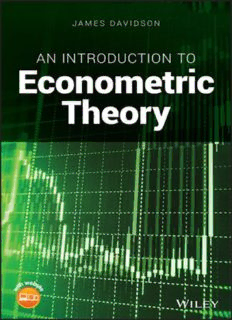Table Of ContentAnIntroductiontoEconometricTheory
An Introduction to Econometric Theory
JamesDavidson
UniversityofExeter
UK
Thiseditionfirstpublished2018
©2018JohnWiley&SonsLtd
Allrightsreserved.Nopartofthispublicationmaybereproduced,storedinaretrievalsystem,or
transmitted,inanyformorbyanymeans,electronic,mechanical,photocopying,recordingorotherwise,
exceptaspermittedbylaw.Adviceonhowtoobtainpermissiontoreusematerialfromthistitleisavailable
athttp://www.wiley.com/go/permissions.
TherightofJamesDavidsontobeidentifiedastheauthorofthisworkhasbeenassertedinaccordance
withlaw.
RegisteredOffices
JohnWiley&Sons,Inc.,111RiverStreet,Hoboken,NJ07030,USA
JohnWiley&SonsLtd,TheAtrium,SouthernGate,Chichester,WestSussex,PO198SQ,UK
EditorialOffice
9600GarsingtonRoad,Oxford,OX42DQ,UK
Fordetailsofourglobaleditorialoffices,customerservices,andmoreinformationaboutWileyproducts
visitusatwww.wiley.com.
Wileyalsopublishesitsbooksinavarietyofelectronicformatsandbyprint-on-demand.Somecontentthat
appearsinstandardprintversionsofthisbookmaynotbeavailableinotherformats.
LimitofLiability/DisclaimerofWarranty
Whilethepublisherandauthorshaveusedtheirbesteffortsinpreparingthiswork,theymakeno
representationsorwarrantieswithrespecttotheaccuracyorcompletenessofthecontentsofthisworkand
specificallydisclaimallwarranties,includingwithoutlimitationanyimpliedwarrantiesofmerchantabilityor
fitnessforaparticularpurpose.Nowarrantymaybecreatedorextendedbysalesrepresentatives,written
salesmaterialsorpromotionalstatementsforthiswork.Thefactthatanorganization,website,orproductis
referredtointhisworkasacitationand/orpotentialsourceoffurtherinformationdoesnotmeanthatthe
publisherandauthorsendorsetheinformationorservicestheorganization,website,orproductmayprovide
orrecommendationsitmaymake.Thisworkissoldwiththeunderstandingthatthepublisherisnotengaged
inrenderingprofessionalservices.Theadviceandstrategiescontainedhereinmaynotbesuitableforyour
situation.Youshouldconsultwithaspecialistwhereappropriate.Further,readersshouldbeawarethat
websiteslistedinthisworkmayhavechangedordisappearedbetweenwhenthisworkwaswrittenandwhen
itisread.Neitherthepublishernorauthorsshallbeliableforanylossofprofitoranyothercommercial
damages,includingbutnotlimitedtospecial,incidental,consequential,orotherdamages.
LibraryofCongressCataloging-in-PublicationData:
Names:Davidson,James,1944-author.
Title:Anintroductiontoeconometrictheory/byProf.JamesDavidson,UniversityofExeter.
Description:Hoboken,NJ:JohnWiley&Sons,Inc.,[2018]|Includesbibliographicalreferencesandindex.|
Identifiers:LCCN2018009800(print)|LCCN2018011202(ebook)|ISBN9781119484936(pdf)|
ISBN9781119484929(epub)|ISBN9781119484882(cloth)
Subjects:LCSH:Econometrics.
Classification:LCCHB139(ebook)|LCCHB139.D36642018(print)|DDC330.01/5195–dc23
LCrecordavailableathttps://lccn.loc.gov/2018009800
CoverDesign:Wiley
CoverImage:©maciek905/iStockphoto
Setin10/12ptWarnockProbySPiGlobal,Chennai,India
10 9 8 7 6 5 4 3 2 1
v
Contents
ListofFigures ix
Preface xi
AbouttheCompanionWebsite xv
PartI Fitting 1
1 ElementaryDataAnalysis 3
1.1 VariablesandObservations 3
1.2 SummaryStatistics 4
1.3 Correlation 6
1.4 Regression 10
1.5 ComputingtheRegressionLine 12
1.6 MultipleRegression 16
1.7 Exercises 18
2 MatrixRepresentation 21
2.1 SystemsofEquations 21
2.2 MatrixAlgebraBasics 23
2.3 RulesofMatrixAlgebra 26
2.4 PartitionedMatrices 27
2.5 Exercises 28
3 SolvingtheMatrixEquation 31
3.1 MatrixInversion 31
3.2 DeterminantandAdjoint 34
3.3 TransposesandProducts 37
3.4 Cramer’sRule 38
3.5 PartitioningandInversion 39
3.6 ANoteonComputation 41
3.7 Exercises 43
4 TheLeastSquaresSolution 47
4.1 LinearDependenceandRank 47
4.2 TheGeneralLinearRegression 50
vi Contents
4.3 DefiniteMatrices 52
4.4 MatrixCalculus 56
4.5 GoodnessofFit 57
4.6 Exercises 59
PartII Modelling 63
5 ProbabilityDistributions 65
5.1 ARandomExperiment 65
5.2 PropertiesoftheNormalDistribution 68
5.3 ExpectedValues 72
5.4 DiscreteRandomVariables 75
5.5 Exercises 80
6 MoreonDistributions 83
6.1 RandomVectors 83
6.2 TheMultivariateNormalDistribution 84
6.3 OtherContinuousDistributions 87
6.4 Moments 90
6.5 ConditionalDistributions 92
6.6 Exercises 94
7 TheClassicalRegressionModel 97
7.1 TheClassicalAssumptions 97
7.2 TheModel 99
7.3 PropertiesofLeastSquares 101
7.4 TheProjectionMatrices 103
7.5 TheTrace 104
7.6 Exercises 106
8 TheGauss-MarkovTheorem 109
8.1 ASimpleExample 109
8.2 EfficiencyintheGeneralModel 111
8.3 FailureoftheAssumptions 113
8.4 GeneralizedLeastSquares 114
8.5 WeightedLeastSquares 116
8.6 Exercises 118
PartIII Testing 121
9 EigenvaluesandEigenvectors 123
9.1 TheCharacteristicEquation 123
9.2 ComplexRoots 124
9.3 Eigenvectors 126
9.4 Diagonalization 128
Contents vii
9.5 OtherProperties 130
9.6 AnInterestingResult 131
9.7 Exercises 133
10 TheGaussianRegressionModel 135
10.1 TestingHypotheses 135
10.2 IdempotentQuadraticForms 137
10.3 ConfidenceRegions 140
10.4 tStatistics 141
10.5 TestsofLinearRestrictions 144
10.6 ConstrainedLeastSquares 146
10.7 Exercises 149
11 PartitioningandSpecification 153
11.1 ThePartitionedRegression 153
11.2 Frisch-Waugh-LovellTheorem 155
11.3 MisspecificationAnalysis 156
11.4 SpecificationTesting 159
11.5 StabilityAnalysis 160
11.6 PredictionTests 162
11.7 Exercises 163
PartIV Extensions 167
12 RandomRegressors 169
12.1 ConditionalProbability 169
12.2 ConditionalExpectations 170
12.3 StatisticalModelsContrasted 174
12.4 TheStatisticalAssumptions 176
12.5 PropertiesofOLS 178
12.6 TheGaussianModel 182
12.7 Exercises 183
13 IntroductiontoAsymptotics 187
13.1 TheLawofLargeNumbers 187
13.2 ConsistentEstimation 192
13.3 TheCentralLimitTheorem 195
13.4 AsymptoticNormality 198
13.5 MultipleRegression 201
13.6 Exercises 203
14 AsymptoticEstimationTheory 207
14.1 LargeSampleEfficiency 207
14.2 InstrumentalVariables 208
14.3 MaximumLikelihood 210
14.4 GaussianML 213
viii Contents
14.5 PropertiesofMLEstimators 214
14.6 LikelihoodInference 216
14.7 Exercises 218
PartV Appendices 221
A TheBinomialCoefficients 223
B TheExponentialFunction 225
C EssentialCalculus 227
D TheGeneralizedInverse 229
RecommendedReading 233
Index 235
ix
ListofFigures
Figure1.1 LongandshortUKinterestrates 7
Figure1.2 Scatterplotoftheinterestrateseries 8
Figure1.3 Theregressionline 10
Figure1.4 Theregressionlineandthedata 10
Figure1.5 Theregressionresidual 11
Figure1.6 Plotofy=2+2x +x 17
1 2
Figure5.1 Archerytargetscatter 66
Figure5.2 Archerytarget,frequencycontours 67
Figure5.3 Bivariatenormalprobabilitydensityfunction 67
Figure5.4 Normalp.d.f.,shadedareashowsPr(1<X <2) 70
Figure5.5 Binomialprobabilitiesandthenormalp.d.f.Source:Figure23.2of
StochasticLimitTheory:AnIntroductionforEconometricians(Advanced
TextsinEconometrics)byJamesDavidson(1994).Reproducedby
permissionofOxfordUniversityPress. 77
Figure5.6 Prussiancavalrydataandpredictions 79
Figure6.1 ThestandardCauchyp.d.f. 88
Figure10.1 Regressionconfidenceregions,k =2.Source:Figure2.1ofEconometric
TheorybyJamesDavidson,BlackwellPublishers2000.Reproducedby
permissionofWiley-Blackwell. 141
Figure13.1 P.d.fofthesumofthreeuniformr.v.s,withnormalp.d.f.forcomparison.
Source:Figure23.1ofStochasticLimitTheory:AnIntroductionfor
Econometricians(AdvancedTextsinEconometrics)byJamesDavidson
(1994).ReproducedbypermissionofOxfordUniversityPress. 197
xi
Preface
This book has its origin in a course of lectures offered to second year economics
undergraduateswhoaresimultaneouslytakingacoremoduleinappliedeconometrics.
Courses of the latter type, typically based on excellent texts such as Wooldridge’s
Introductory Econometrics or Stock and Watson’s Introduction to Econometrics, teach
modern techniques of model building and inference, but necessarily a good deal
of technical material has to be taken on trust. This is like following a cake recipe
that dictates ingredients in given proportions and then the baking time and oven
temperature but does not tell you why these instructions give a good result. One can
drive a car without knowing anything about spark plugs and transmissions, but one
cannot so easily fix it. For students with the requisite motivation, these lectures have
aimedtoprovidealookunderthebonnet(beingBritish;theirAmericancounterparts
wouldofcoursebewantingtolookunderthehood).
Aproblemhasbeenthatnoverysuitabletextbookhasexistedtoaccompanythelec-
tures.Thereadinglisthashadtocitechaptersfromvariouslargeandindigestibletexts,
often with special reference to the technical appendices. To master the mathematics
underlyingeconometricmethodsrequiresadetailedstudyofmatrixalgebraandasound
graspofdistributiontheory,andtofindreadingswiththerightfocusandattheright
levelisnoteasy.Sometimes,bookswrittenagenerationagoandnowoutofprintappear
todoabetterjobthanmoderntexts.Hence,thisbook.
Jargon, obscure conventions, and austere expository style all conspire to make this
kindofmaterialhardforbeginnerstoaccess.Thisbookmayormaynotsucceedinits
aim,butitsaimisclear,whichistobesuccessfullyreadbystudentswhodonothave
toomanytechniquesattheirfingertips.Aslittleaspossibleisdonewithoutafullexpla-
nationandcarefulcross-referencingtorelevantresults.Thismaymakethediscussion
long-windedandrepetitiveattimes,buthopefullyitishelpfulifateverystagethereader
istoldwhythingsarebeingdone,andwhatpreviousmaterialisinformingtheargument.
Thestyleisdeliberatelyinformal,withnumberedtheoremsandlemmasavoided.How-
ever, there is no dumbing down! Very few technical results are quoted without some
formofexplanation,demonstration,orproof.
It is expected that readers will have taken the standard mathematics and statistics
courses for economics undergraduates, but the prior knowledge required is actually
quitesmall.Thetreatmentisasfaraspossibleself-contained,withalmostallthemath-
ematicalconceptsneededbeingexplainedeitherinsituorintheappendices.
Description:An Introduction to Econometric Theory offers a text to help in the mastery of the mathematics that underlie econometric methods and includes a detailed study of matrix algebra and distribution theory. Designed to be an accessible resource, the text explains in clear language why things are being don

